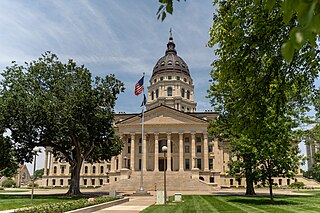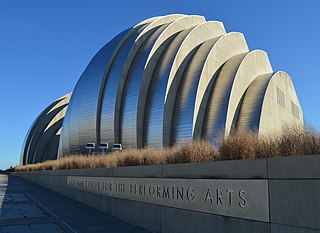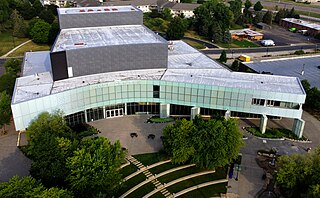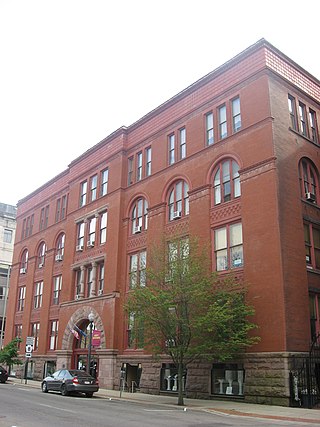
Gypsy Rose Lee was an American burlesque entertainer, stripper, actress, author, playwright and vedette, famous for her striptease act. Her 1957 memoir, Gypsy: A Memoir, was adapted into the 1959 stage musical Gypsy.

Playhouse Square is a theater district in downtown Cleveland, Ohio, United States. It is the largest performing arts center in the US outside of New York City. Constructed in a span of 19 months in the early 1920s, the theaters became a major entertainment hub for the city for much of the 20th century. However, by the late 1960s, the district had fallen into decline and its theaters had closed down. In the 1970s, the district was revived through a grassroots effort that helped usher in a new era of downtown revitalization. For this reason, the revival of Playhouse Square is often locally referred to as being "one of the top ten successes in Cleveland history."

The Kansas State Capitol, known also as the Kansas Statehouse, is the building housing the executive and legislative branches of government for the U.S. state of Kansas. Located in the city of Topeka, which has served as the capital of Kansas since the territory became a state in 1861, the building is the second to serve as the Kansas Capitol. During the territorial period (1854–1861), an earlier capitol building was begun but not completed in Lecompton, Kansas, and smaller structures in Lecompton and Topeka were where the territorial legislatures met.
WIBW is a commercial AM radio station in Topeka, Kansas. It is owned by Alpha Media and airs a talk and sports radio format. The studios and offices are on SW Executive Drive in Topeka. The transmitter is off NW Landon Road in Silver Lake.

The Olympia Theater is a theater located in Miami, Florida. Designed by John Eberson in his famed atmospheric style, the theater opened in 1926. Throughout its history, the venue has served as a movie theater, concert venue and performing arts center. In 1984, it received historical designation by the NRHP. The Olympia Theatre, the Florida Theatre, and the Tampa Theatre are the only remaining atmospheric theatres in Florida.

The Kauffman Center for the Performing Arts is in downtown Kansas City, Missouri, USA, at 16th and Broadway, near the city's Power & Light District, the T-Mobile Center and the Crossroads Arts District. Opened in 2011, it houses two venues: the 1,800-seat Muriel Kauffman Theatre, home of the Kansas City Ballet and Lyric Opera of Kansas City; and the 1,600-seat Helzberg Hall, home of the Kansas City Symphony Orchestra. Both venues host a variety of artists and performance groups in addition to these three resident entities.

The Somerville Theatre is an independent movie theater and concert venue in the Davis Square neighborhood of Somerville, Massachusetts, United States. Over one hundred years old, the Somerville Theatre started off as a vaudeville house and movie theater. The theater has since transitioned and now operates as a live music venue and first-run movie theater. As a music venue, the theater has played host to many historic concerts, including the first of the two Last Dispatch concerts, two shows by Bruce Springsteen in 2003, and a performance by U2 in 2009. Recent live performances have included Ryan Adams & the Cardinals, Cursive, Norah Jones, The Jonas Brothers, Joan Baez, and the John Butler Trio.

The Connor Palace, also known as the Palace Theatre and historically as the RKO Palace, is a theater located at 1615 Euclid Avenue in Downtown Cleveland, Ohio, part of Playhouse Square.

An atmospheric theatre is a type of movie palace design which was popular in the late 1920s. Atmospheric theatres were designed and decorated to evoke the feeling of a particular time and place for patrons, through the use of projectors, architectural elements and ornamentation that evoked a sense of being outdoors. This was intended to make the patron a more active participant in the setting.

The Palace Theatre is an entertainment venue in downtown Albany, New York, located on the corner of Clinton Avenue and North Pearl Street. The theatre is operated by the Palace Performing Arts Center, Inc., a 501(c)(3) non-profit organization. Established in 1984 and incorporated as a not-for-profit corporation in 1989, the Palace Performing Arts Center, Inc. was created to operate the theatre and utilize its full potential as a cultural and entertainment center in Albany.

Uptown Oakland is a neighborhood in Oakland, California, located in the northern end of Downtown. It is located roughly between West Grand Avenue to the north, Interstate 980 to the west, City Center and 14th Street to the south, and Broadway to the east. The neighborhood has become an important entertainment district in recent years.

The Civic Center Music Hall is a performing arts center located in Oklahoma City, Oklahoma. It was constructed in 1937 as Municipal Auditorium and renamed in 1966. The facility includes the Thelma Gaylord Performing Arts Theatre, the Freede Little Theatre, CitySpace, the Meinders Hall of Mirrors and the Joel Levine Rehearsal Hall.

The Orpheum Theatre is a historic theater in downtown Wichita, Kansas, United States. It was designed by renowned theatre architect John Eberson with funding from a group of local investors and opened on September 4, 1922.

The Hanover Theatre and Conservatory for the Performing Arts is a complex in Worcester, Massachusetts, that includes an auditorium, where touring acts perform regularly, and several classrooms that host classes relating to the arts.

The Kansas Historical Society is the official state historical society of Kansas.

The Standard Theatre, now known as the Folly Theater and also known as the Century Theater and Shubert's Missouri, is a former vaudeville hall in downtown Kansas City, Missouri. Built in 1900, it was designed by Kansas City architect Louis S. Curtiss. The theater was associated with the adjoining Edward Hotel, which was also designed by Curtiss; the hotel was demolished in 1965.

The Lessing Theater was a theatre in the Mitte district of Berlin, Germany. It opened in 1888 and was destroyed in April 1945 in a bombing raid; its ruins were demolished after World War II.

The Ames Center, formerly the Burnsville Performing Arts Center, is a performing arts venue in Burnsville, Minnesota, adjacent to Nicollet Commons Park, which features green space, water fountains, and a 250-seat outdoor performance amphitheater. The Ames Center features an eclectic range of performances on the main stage and the black box theatres including: dance, theatre, concerts, comedians, and written word. Past performances include the Girl Singers of the Hit Parade, Larry Carlton, Louie Anderson, Lori Lane, Richard Marx, Church Basement Ladies, Melissa Manchester, Bill Engvall, Nick Colionne, Celtic Crossroads, Twin Cities Ballet of Minnesota, Elizabeth Gilbert, Rob Lake, Tommy Emmanuel, Sinbad, Ralphie May, Dakota Valley Symphony, Chameleon Theater Circle, Miss Minnesota USA/Teen USA, and Cirque D’Or. Additionally, productions of Mame, A Christmas Carol and Peter Pan were presented utilizing sets created for the Kennedy Center, the Kodak Theatre and the original Cathy Rigby Broadway production respectively.

The National Transit Building is an historic, American commercial building that is located at 206 Seneca Street, Oil City, Venango County, Pennsylvania.




















